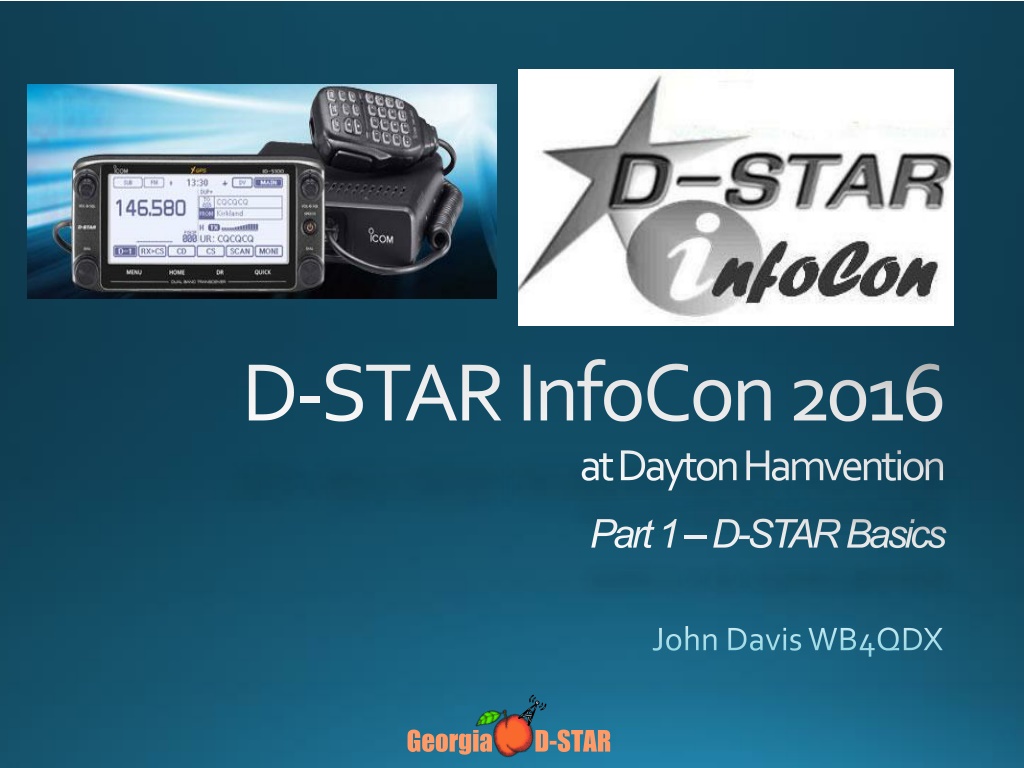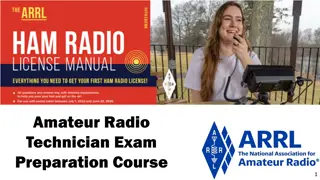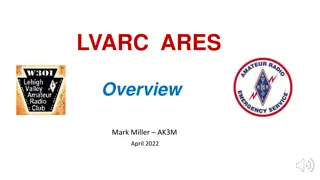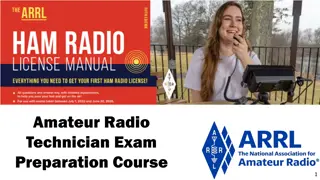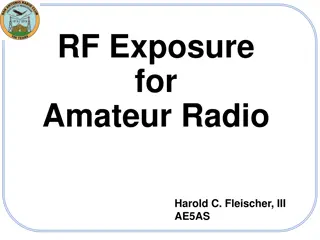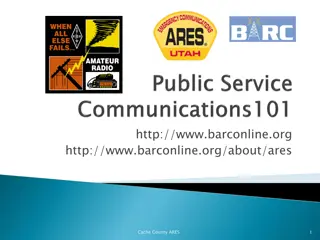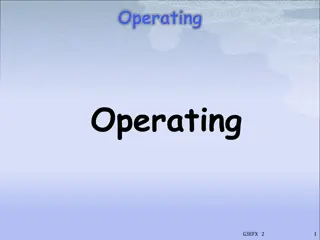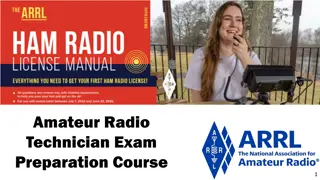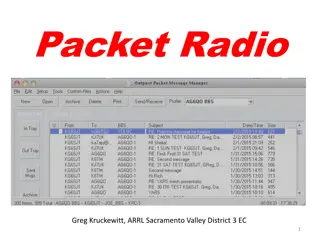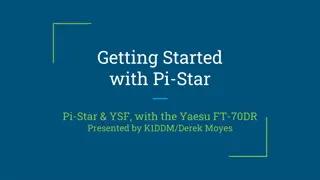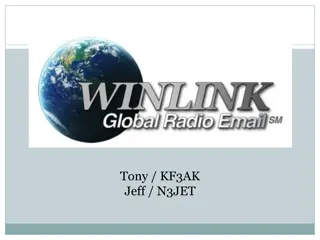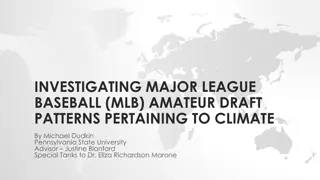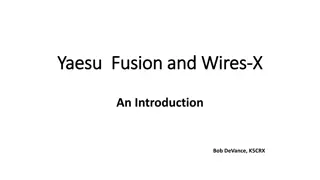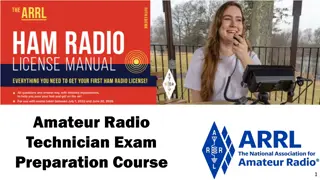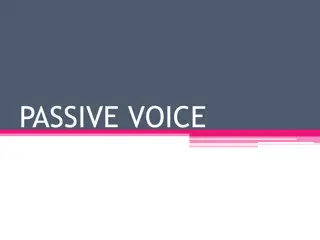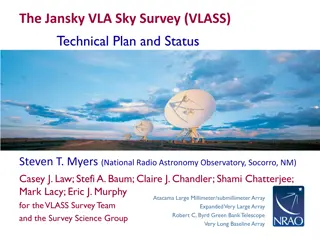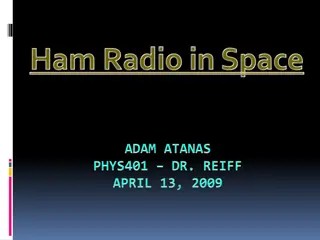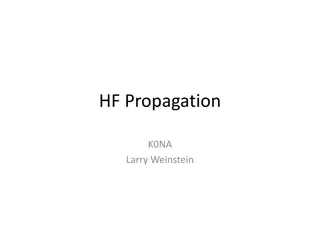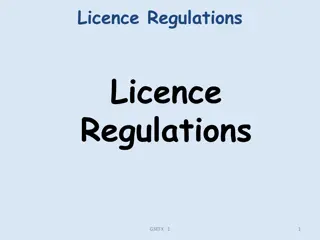Understanding D-STAR: A Comprehensive Guide to Digital Voice and Data for Amateur Radio
D-STAR is an open standard for digital voice and data in Amateur Radio, developed by the Japan Amateur Radio League (JARL). It uses the AMBE vocoder chip to convert analog speech to data and vice versa, leading the way in encouraging experimentation and open development. The technology ensures high-quality voice transmission, occupies less spectrum than analog FM, and allows voice and data to be combined in a single data stream. D-STAR facilitates user-friendly communication through digital modulation, offering features such as error correction, data transmission, and various linking options.
Uploaded on Sep 30, 2024 | 0 Views
Download Presentation

Please find below an Image/Link to download the presentation.
The content on the website is provided AS IS for your information and personal use only. It may not be sold, licensed, or shared on other websites without obtaining consent from the author. Download presentation by click this link. If you encounter any issues during the download, it is possible that the publisher has removed the file from their server.
E N D
Presentation Transcript
D-STAR InfoCon2016 at Dayton Hamvention Part 1 D-STAR Basics John Davis WB4QDX D-STAR Georgia
What is D-STAR? D-STAR is an open standard for digital voice and data designed specifically for Amateur Radio One of several digital modes used in Amateur Radio Developed by Japan Amateur Radio League (JARL) Uses AMBE vocoder chip from DVSI to convert analog speech to data and vice versa D-STAR has lead the way encouraging experimentation and open development 2 of 19 D-STAR Georgia
Digital Basics Digital voice does not gradually degrade in quality as signal level decreases Digital vs Analog 100 Digital 80 Readability 60 Analog 40 20 Threshold 0 100 90 80 70 60 50 40 30 20 10 0 Signal Strength % D-STAR Georgia
Digital Basics Voice (analog) is converted to data Data may be added to voice to produce a single data stream containing voice and data Radio is modulated as a data carrier Occupied bandwidth is determined by data bit rate and type of modulation Generally, digital voice and data occupies less spectrum than analog FM Narrowband Digital D-STAR Georgia
Digital Mode Comparison D-STAR DMR/MotoTRBO System Fusion Number of users >46,000 >30,000 >1,000 >3,000 >500 >1,500 (most operating in mixed or FM modes) Repeaters 6.25 KHz 7.6 KHz 7.6-9 KHz Bandwidth 10, 12.5 KHz pairs 12.5 KHz pairs 20, 25 KHz pairs Channel spacing Open via Internet (DPLUS or ircDDB) Proprietary (Motorola IPSC), Hytera or special limit3ed reflectors via Internet Not yet available Wires-X nodes connect to radio Repeater Linking Determined by user, sent from radio Defined by admin, sent from radio Not yet available for repeater (Repeater firmware upgrade required) Linking / routing control 1200, 3600 bps SMS only implemented in Amateur Radio version 4800, 9600 bps Data 128 kbps (1.2 GHz) Front panel, software Licensed software Front panel, software Radio Programming Multiple vendors (Dongle, DVAP, GMSK modems, hotspot adapters) Multiple radio vendors, multi- mode devices available with limited networking Not yet Other user devices D-STAR Georgia
How does D-STAR work? Voice is converted to digital modulation and transmitted at 4800 bps 2400 bits for voice 1200 bits for Forward Error Correction on voice 1200 bits for data (error correction usually in applications True narrowband digital signal Voice and data occupy one 6.25 KHz signal (versus wider bandwidth for FM voice, P25 and MotoTRBO) Can operate simplex, repeater or linked to other repeater(s) 6 of 19 D-STAR Georgia
What can D-STAR Do? Transmit or receive voice and 1200 baud data simultaneously on 2m, 440 and 1.2 GHz (no TNC required) 128 Kb data transmission on 1.2 GHz with Internet connectivity (Ethernet bridge to Internet with IP address) D-PRS (digital APRS) automatic position reporting simultaneous with voice with GPS Flexible repeater linking with Gateway and Internet connection Reflectors act as conference bridge for linking multiple repeaters (77 DPLUS Reflectors, >100 DCS and XRF Reflectors now in operation worldwide) DV Dongle, DV Access Point (DVAP) / Hotspots and DV Node Adapters allow voice and data access to D-STAR via Internet connection (similar to EchoLink) 7 of 19 D-STAR Georgia
D-STAR Growth Continues As of May 1, 2016 over 3,200 Voice Repeaters, 222 Data Modules and over 47,000 registered users on US Trust Server. Over 1,100 repeaters in US Additional ircDDB repeaters and users Gateways Users Repeaters 1400 50000 3500 45000 1200 3000 40000 1000 2500 35000 30000 800 2000 25000 600 1500 20000 15000 400 1000 10000 200 500 5000 0 0 0 7 8 9 10 11 12 13 14 15 8 9 10 11 12 13 14 15 7 8 9 10 11 12 13 14 15 D-STAR Georgia
D-STAR Equipment D-STAR radios (mobiles, handhelds, repeaters) commercially produced by ICOM (new major manufacturer announcing soon) DV Dongle is non-radio device allowing access to repeaters and reflectors via Internet (similar to EchoLink) DV Access Point (DVAP) creates low power hotspot via Internet Hotspot boards create low power access point with Raspberry Pi Node Adapters converts FM transceiver to D-STAR hotspots and repeaters 9 of 19 D-STAR Georgia
Icom Radios Offers line of mobiles, handhelds and repeaters Most radios are dual band (2m, 70cm) ID-31A is 70cm only ID-1 is 23cm only, allows high speed data All radios operate standard FM and D-STAR digital modes All Icom radios have built-in serial port for data transmission All offer GPS as built-in, a part of speaker/mic or connection via serial or USB port 10 of 19 D-STAR Georgia
Icom Mobiles IC-2200 and ID-800 were initial mobiles D-STAR board can be added to IC-2200 ID-880 updated ID-800 with improved user functions Dual-band, single receive mobile IC-2820 is full featured mobile Dual-band, dual receive Built-in GPS with external antenna New ID-5100 mobile offers new features Dual-Band, dual receive GPS built into head unit Touchscreen display Optional Bluetooth interface DR Mode with 1200 geocoded memories 11 of 19 D-STAR Georgia
Icom Handhelds IC-91AD was initial D-STAR handheld Dual-band, dual receive IC-92AD dual-band, dual receive Slightly larger frame with more heat sink Waterproof GPS spkr/mic optional accessory IC-80 introduced as lower cost handheld Dual-band, single receive GPS spkr/mic accessory available ID-31A is 70cm handheld Waterproof SD card for memory storage, update memory from downloads Built-in GPS User friendly DR Mode, locate closest repeater ID-51A is latest dual band handheld All features of ID-31A, but dual band, dual receive Anniversary Edition/Plus model includes nearest FM repeater location 3X data rate with other 51A/5100 radios 12 of 19 D-STAR Georgia
ID-1 for 1.2 GHz Voice and Data Operates FM, Digital Voice (DV), low speed data and high speed data (DV) High speed data connection is Ethernet compatible Acts as Ethernet bridge 13 of 19 D-STAR Georgia
D-STAR Repeater Architecture Linux Gateway PC Running G2 Gateway software Runs third-party apps, Dongle, DVAP 14 of 19 D-STAR Georgia
The Registration Process Why register? Registering your callsign allows access to more functions on DPLUS repeaters (not required for ircDDB repeaters) Register on your local or the closest system, if possible Register on one and only one system (local registration syncs with all systems throughout world) Registration is a three-step process (all three steps must be completed) 15 of 19 D-STAR Georgia
Starting Registration Step 1 Browse to desired system and register as new user (https://callsign.dstargateway.org/Dstar.do) 16 16 of 19 D-STAR Georgia
Fill Out Your Info Fill out the info (callsign, name, email address and desired password) Step 2 System administrator must approve your initial registration. You may need to send email to admin. 17 of 19 D-STAR Georgia
Add a Terminal Step 3 Add at least one terminal with a space in first row under Initial, then type a pc-name (lower case, e.g. wb4qdx-dstar) Note: You only need one terminal, a space for use. Adding more terminals can add confusion 18 of 19 D-STAR Georgia
Add Your Callsign to Radio For a radio, program your callsign (caps, no spaces) in MYCALL or MY field Found in Menu under MY STATION in newer radios For a DVAP, DV Dongle or Hotspot, program call in callsign field exactly as entered in registration terminal Get on and talk! 19 of 19 D-STAR Georgia
